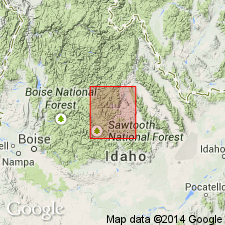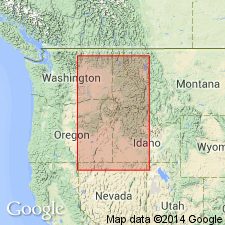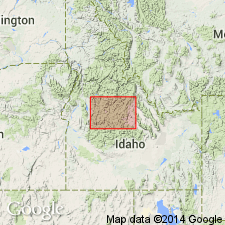
- Usage in publication:
-
- Germer tuffaceous member*
- Modifications:
-
- Named
- Dominant lithology:
-
- Tuff
- AAPG geologic province:
-
- Idaho Mountains province
Summary:
Named as a member of the Challis volcanics for Germer Basin, north-central part of Bayhorse quad, T12N, R19E, Custer Co, ID in the Idaho Mountains province. No type locality designated. Shown on geologic map as a middle member of the Challis, younger than the latite-andesite member of the Challis, and older than basalt of the Challis. At some localities, Germer makes up the entire Challis. Composed mostly of medium- to fine-grained, cream-buff to light-brown tuff. Some of the tuff shows bedding and sorting by water. Some beds are harder and denser than the others. The unsorted tuff is composed of fragments of crystals of igneous minerals about a millimeter in maximum diameter--fragments of oligoclase, quartz, shreds of biotite, and a little hornblende in a groundmass obscured by silicification. Has some pumice beds. Also locally has some bands of silt and clay, and some conglomerate of pebbles (2 inches to 1 ft) from Paleozoic formations and from granites cemented by silica, quartz, or quartzite. Exceeds 1,000 ft thick; base not exposed. Was the product of explosive volcanism. Wood fragments (logs, stumps) and leaves identified; invertebrates, fish and insect remains. Determined to be late Oligocene or early Miocene age on basis of plants.
Source: GNU records (USGS DDS-6; Denver GNULEX).

- Usage in publication:
-
- Germer tuffaceous member
- Modifications:
-
- Geochronologic dating
- AAPG geologic province:
-
- Idaho Mountains province
Summary:
A sample of biotite quartz latite taken from the Germer along Rte 93, 4 mi north of Salmon, Lemhi Co, ID in the Idaho Mountains province dated by K-Ar method as 45.5 m.y.
Source: GNU records (USGS DDS-6; Denver GNULEX).

- Usage in publication:
-
- Germer Tuffaceous Member*†
- Modifications:
-
- Abandoned
Summary:
Challis raised in stratigraphic rank to Challis Volcanic Group. Term Germer Tuffaceous member abandoned. Germer has fallen into disuse and does not adequately describe the stratigraphic relations as understood. Was formerly used in Custer County, Idaho (Idaho Mountains province).
Source: GNU records (USGS DDS-6; Denver GNULEX).
For more information, please contact Nancy Stamm, Geologic Names Committee Secretary.
Asterisk (*) indicates published by U.S. Geological Survey authors.
"No current usage" (†) implies that a name has been abandoned or has fallen into disuse. Former usage and, if known, replacement name given in parentheses ( ).
Slash (/) indicates name conflicts with nomenclatural guidelines (CSN, 1933; ACSN, 1961, 1970; NACSN, 1983, 2005, 2021). May be explained within brackets ([ ]).

